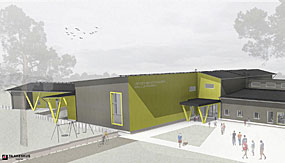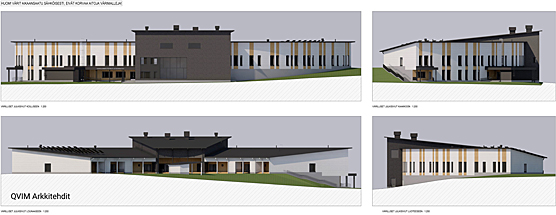
The community service centre of Kuopio’s western rural areas. © Kuopion tilakeskus
Kuopio intends its new constructions to be as sustainable and climate-friendly as possible. The facilities at the Kuikkalampi daycare centre and the community service centre of Kuopio’s western rural areas have been efficiently designed to support new ways of learning, while keeping the buildings’ carbon footprint under control.
New and traditional methods converge in a log-built school
The community service centre of Kuopio’s western rural areas, currently in its planning phase, will be a log-built school house providing facilities to 220 pupils from daycare to the 6th grade. The aim is to build a modern school based on the new learning principles, in which the traditional classrooms are replaced by open learning environments.
‘The pupils can utilise all the facilities efficiently. The rooms can be modified to function as teaching rooms of various types and sizes, which means that overall we will need less space,’ says project planning architect Emilia Rönkkö from Kuopion Tilakeskus.
The school building will also be made available for evening use as a meeting place for the city’s residents, and the Community College can take advantage of the school’s crafts facilities. Furthermore, the school’s PE facilities can be used to organise group exercise sessions for the city’s residents.
Managing the carbon footprint
Three school buildings that have come to the end of their lifecycle will be combined under the roof of the new community service centre. The energy for the building is generated by a geothermal system and a set of solar panels, whose number can be optimised based on calculations.
During the Kiihdyttämö (‘Accelerator’) project, calculations were made on the possible reductions in energy costs and emissions if the old school buildings were replaced with a single new one. The calculations also accounted for the emissions caused by school transport.
‘Even though the distance from home to school will increase for some of the pupils, thereby increasing the total transport distance by 70 per cent, we will be able to make energy savings of up to 60 per cent in comparison to the current situation,’ says Rönkkö. ‘Based on the report, we can provide decision-makers with concrete figures to support their work.’
Constructing a large school building with logs poses its own challenges to the building’s design.
The building’s fire safety required additional research, especially since the water supply network in the more sparsely populated areas has less output power than its urban counterpart. Therefore similar projects, such as the log-built school in Iisalmi, have been studied for solutions.
Diverse energy solutions at the daycare centre
The design of the Kuikkalampi daycare centre, currently being constructed, is based on versatility, easy maintenance and healthiness.
The energy for the new daycare centre, which will be opening its doors in early 2020, will come from a diverse range of sources. The daycare centre will use district heat in the winter and a geothermal energy system for cooling in the summer. Furthermore, electricity for the building will be generated with solar panels.
‘The experts at the Finnish Environment Institute are currently calculating the building’s carbon footprint during its entire lifecycle and the extent to which it can be reduced with the solar panels, for example. In addition to this, we have created models of the effects of different building materials,’ says the City of Kuopio’s environmental expert Minna Kuuluvainen.

Kuikkalampi daycare centre. © QVIM arkkitehdit
The new daycare centre has room for 150 children, which makes it one of the city’s biggest daycare units, and it will also be used for youth activities, after school clubs and sports services during the evenings, weekends and summer months. This will significantly increase the building’s utilisation rate.
Kuopio’s new school buildings will serve as models and examples for future construction projects.
‘The city must assess the environmental impact of every project. The calculations made during these pilot projects have already helped us to make more accurate and detailed assessments of the environmental effects of construction projects,’ says Kuuluvainen.